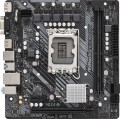Add to comparison |  |  |
|---|---|---|
| ASRock H610M-HDV | ASRock H610M-HVS | |
| Compare prices 1 | Compare prices 2 | |
| TOP sellers | ||
| Features | for home/office | for home/office |
| Socket | Intel LGA 1700 | Intel LGA 1700 |
| Form factor | micro-ATX | micro-ATX |
| Power phases | 5 | 5 |
| Size (HxW) | 197x188 mm | 197x188 mm |
Chipset | ||
| Chipset | Intel H610 | Intel H610 |
| BIOS | Ami | Ami |
| UEFI BIOS | ||
RAM | ||
| DDR4 | 2 slot(s) | 2 slot(s) |
| Memory module | DIMM | DIMM |
| Operation mode | 2 channel | 2 channel |
| Max. clock frequency | 3200 MHz | 3200 MHz |
| Max. memory | 64 GB | 64 GB |
| XMP | ||
Drive interface | ||
| SATA 3 (6Gbps) | 4 | 4 |
Expansion slots | ||
| 1x PCI-E slots | 1 | 1 |
| PCI-E 16x slots | 1 | 1 |
| PCI Express | 4.0 | 4.0 |
Internal connections | ||
| TPM connector | ||
| USB 2.0 | 1 | 1 |
| USB 3.2 gen1 | 1 | 1 |
Video outputs | ||
| D-Sub output (VGA) | ||
| HDMI output | ||
| HDMI version | v.2.1 | v.2.1 |
| DisplayPort | ||
| DisplayPort version | v.1.4 | |
Integrated audio | ||
| Audiochip | Realtek ALC897 /887/ | Realtek ALC897 /887/ |
| Sound (channels) | 7.1 | 7.1 |
Network interfaces | ||
| LAN (RJ-45) | 1 Gbps | 1 Gbps |
| LAN ports | 1 | 1 |
| LAN controller | Realtek RTL8111H | Realtek RTL8111H |
External connections | ||
| USB 2.0 | 4 | 4 |
| USB 3.2 gen1 | 2 | 2 |
| PS/2 | 1 | 1 |
Power connectors | ||
| Main power socket | 24 pin | 24 pin |
| CPU power | 8 pin | 8 pin |
| Fan power connectors | 3 | 3 |
| CPU Fan 4-pin | 1 | 1 |
| Chassis/Water Pump Fan 4-pin | 2 | 2 |
| Added to E-Catalog | january 2022 | january 2022 |